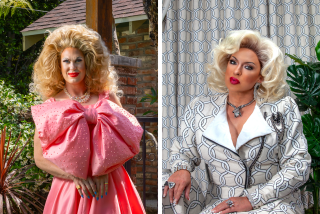Whirling Flourishes
Near the end of the 19th century, belly dancing was performed in the company of women only. But that won’t be the case Saturday at the fourth annual Belly Dancing Awards at Cal State Northridge.
Hosted by the International Academy of Middle Eastern Dance in Van Nuys, the program will include performances by 32 of the top belly dancers from the United States, Canada, Germany and Brazil. Suzy Evans, president of the dance academy, said the event is modeled after the Academy Awards and is designed to elevate the status of belly dancing.
“There’s a lot more to the dance than shaking your hips,” said Jillina Carlano, a nominee for best modern Egyptian dancer. “There are dancers in this country that misrepresent the dance. A lot of people think we’re like strippers. I try to bring it to another level. For the Middle Eastern community, we perform at bridal showers, baby showers and weddings.”
Known in the Middle East as Oriental dance, its roots are planted in fertility rituals and ancient pre-Islamic ceremonies.
“One of the real beauties of the dance is interpreting the classical Arabic music,” said Carlano, a former jazz and ballet dancer. “Someone from Brazil may have a different feel, moves and styling.”
Some of the other award categories include folkloric dance, cabaret dance--a combination of American and Turkish movements--and best innovation. Recognition will be given as well to musicians, such as Gamal Goma, Egypt’s top percussionist and now a Reseda resident.
“The beat is the most important thing in Middle Eastern dance,” Goma said. “Belly dancers follow the beat more than the music. For every dancer, I adjust the beat to the way she dances. In Egypt, we have 99 different rhythms. For belly dance in the United States, we use about 10 different rhythms.”
Unlike many ballet and jazz dancers, belly dance soloists develop their own choreography and design their own costumes, said Carlano, who travels to Egypt every year to study with that country’s top choreographers.
“With ballet, you have specific steps,” said Carlano, an instructor at Synthesis Dance Studio in Studio City. “[Belly dancing] is not that academic. You have a lot of artistic freedom.”
Belly dancing was introduced to the United States in 1893 at the Chicago World’s Fair. By the early 1900s, Hollywood had added flowing veils and bare midriffs and plunked dancers in front of vast audiences in silent movie theaters.
“The hip movements are African, the torso articulations are out of the Turkish areas of the world and the arm movements are Persian,” said Morocco, one of the leading belly dance performers and teachers in the United States. “These are areas of the world that had a high civilization and widespread trade. It is a folk dance. It is not something that women do for men--except in brothels.”
Middle Easterners have a love-hate relationship with belly dancers, Carlano said.
“They invite you to their most important events, but they probably don’t want their daughters to become one,” she said.
One of Saturday’s performances is expected to be an original Oriental ballet, in which Jindra Payne, 22, of Huntington Beach will be performing belly dance on pointe.
“This is a whole new medium we are developing,” said Hallah Moustafa, choreographer and vice president of the International Academy of Middle Eastern Dance. “Belly dance makes women very powerful.”
Also expected Saturday are two of the world’s most acclaimed belly dancers, Hadia and Hayet El Helwa.
BE THERE
Fourth annual Belly Dancing Awards, Saturday at 7 p.m., Cal State Northridge Performing Arts Center, 18111 Nordhoff St., Northridge. General admission $25. Call (818) 677-2488 or (818) 343-4410.
More to Read
The biggest entertainment stories
Get our big stories about Hollywood, film, television, music, arts, culture and more right in your inbox as soon as they publish.
You may occasionally receive promotional content from the Los Angeles Times.










